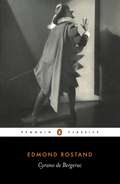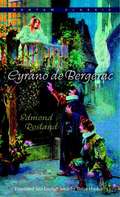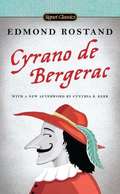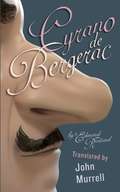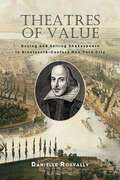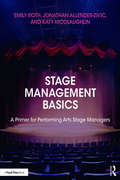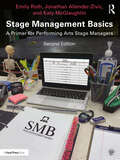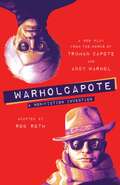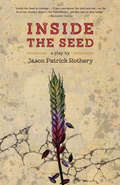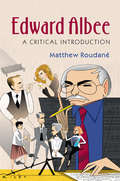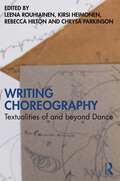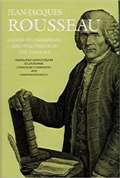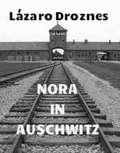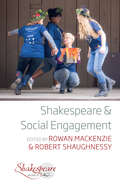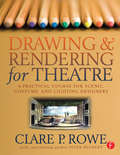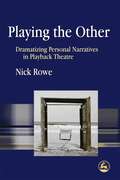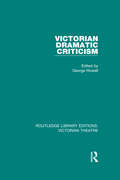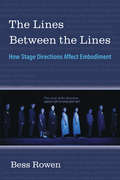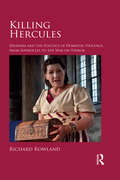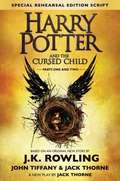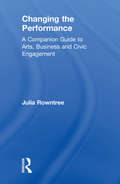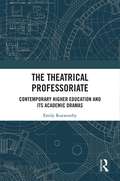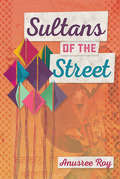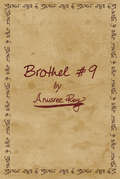- Table View
- List View
Cyrano de Bergerac
by Edmond RostandPoet and soldier, brawler and charmer, Cyrano de Bergerac is desperately in love with Roxane, the most beautiful woman in Paris. But there is one very large problem - he has a nose of stupendous size and believes she will never see past it to return his feelings. So when he discovers that the handsome but tongue-tied Christian is also pining for Roxane, generous Cyrano offers to help by writing exquisite declarations of love for the young man to woo her with. Will she ever recognize who she is really falling in love with? Set during the reign of Louis XIII, Rostand's Cyrano de Bergerac (1897) was one of the great theatrical successes of its time and remains as popular today for its dramatic power and, above all, for its good-natured, passionate and swashbuckling hero.
Cyrano de Bergerac: A Heroic Comedy in Five Acts
by Edmond Rostand Brian HookerThis is Edmond Rostand's immortal play in which chivalry and wit, bravery and love are forever captured in the timeless spirit of romance. Set in Louis XIII's reign, it is the moving and exciting drama of one of the finest swordsmen in France, gallant soldier, brilliant wit, tragic poet-lover with the face of a clown. Rostand's extraordinary lyric powers gave birth to a universal hero--Cyrano De Bergerac--and ensured his own reputation as author of one of the best-loved plays in the literature of the stage. This translation, by the American poet Brian Hooker, is nearly as famous as the original play itself, and is generally considered to be one of the finest English verse translations ever written.
Cyrano De Bergerac
by Edmond Rostand Eteel Lawson Cynthia B. Kerr Lowell BairRegarded as one of the greatest dramas ever written, Cyrano de Bergerac is the story of the silver-tongued soldier whose unfortunate looks drive him to woo his love by speaking for his handsome but dull-witted rival. Cyrano de Bergerac occupies a unique place in the modern theater. Deliberately disavowing realism and contemporary relevance, Edmond Rostand's masterpiece represents a turning back in both time and spirit to an earlier age of high adventure and soaring idealism. Its magnificent hero, Cyrano--noble of soul and grotesque in appearance, gallant Gascon soldier, brilliant wit, and timid lover, alternately comic, heroic, tragic--represents one of the most challenging of all acting roles in its complexity and mercurial changes of mood. From its original production to the present day, Cyrano de Bergerac has enjoyed a charmed existence on the stage, its unflagging pace of action and eloquence of language enchanting critics and public alike. Here, in a superlative translation, is the ultimate triumph of the great French romantic tradition--a work which, in the words of the French critic Lemaître, "prolongs, unites and blends...three centuries of comic fantasy and moral grace." Translated by Lowell Bair With an Introduction by Eteel Lawson and an Afterword by Cynthia B. Kerr
Cyrano de Bergerac
by Edmond Rostand John MurrellThis beloved classic has fascinated and enchanted generations. Not since 1938 has there been a more readable or stageable prose translation. Its fast-paced plot and rich tapestry of gallant soldiers, starving poets, musketeers, marquises, and bluestockings delight, but at its heart is Cyrano: masterful soldier, accomplished poet, ferocious orator, chivalrous lover... and the possessor of an extraordinary nasal appendage!
Theatres of Value: Buying and Selling Shakespeare in Nineteenth-Century New York City
by Danielle RosvallyTheatres of Value explores the idea that buying and selling are performative acts and offers a paradigm for deeper study of these acts—"the dramaturgy of value." Modeling this multifaceted approach, the book explores six case studies to show how and why Shakespeare had value for nineteenth-century New Yorkers. In considering William Brown's African Theater, P. T. Barnum's American Museum and Lecture Hall, Fanny Kemble's American reading career, the Booth family brand, the memorial statue of Shakespeare in Central Park, and an 1888 benefit performance of Hamlet to theatrical impresario Lester Wallack, Theatres of Value traces a history of audience engagement with Shakespearean cultural capital and the myriad ways this engagement was leveraged by theatrical businesspeople.
Stage Management Basics: A Primer for Performing Arts Stage Managers
by Emily Roth Jonathan Allender-Zivic Katy McGlaughlinWithout assuming any intrinsic prior knowledge of the theatrical field and its associated, specialized terminology, Stage Management Basics covers every aspect of the stage management, from reading a script, meeting with a director and theatre staff, and auditioning, to constructing green digital scripts, communication best practices, and opening night protocol. Additionally, this book features multiple appendices containing stage management form templates, blank version of which are available on its companion website. This book touches on basic principles for stage management for theatre, dance, and opera productions.
Stage Management Basics: A Primer for Performing Arts Stage Managers
by Emily Roth Jonathan Allender-Zivic Katy McGlaughlinStage Management Basics, second edition, offers a deep dive into the basics of stage management for theatre, dance, and opera productions. Without assuming any intrinsic prior knowledge of the theatrical field and its associated, specialized terminology, this book covers every aspect of stage management, from reading a script, meeting with a director and theatre staff, and running auditions to communication best practices and opening night protocol. This new edition features brand new chapters on opera, dance, and unions, information on working with intimacy and fight directors, updated tips and tricks, and vibrant color images. Using simple language and detailed explanations, this book is the perfect primer for the beginning stage management student. The companion website contains blank form templates, chapter comprehension tests, a suggested reading list, glossary flashcards, and more.
WARHOLCAPOTE: A Non-Fiction Invention
by Rob RothAn enthralling play based on lost tapes between two cultural giants and friends—Andy Warhol and Truman Capote.In 1978 Andy Warhol and Truman Capote decided to write a Broadway play. Andy suggested that he record their private conversations over the period of a few months, and that these tapes would be the source material for the play. The tapes were then filed away and forgotten. Their play was never completed. Now, award-winning director Rob Roth brings their vision to life after a years-long search to unearth the eighty hours of tapes between two of the most daring artists of postwar America. WARHOLCAPOTE, based on words actually spoken by the two men, is set in the &’70s and &’80s, toward the end of their close connection and not too long before their untimely deaths. Their special, complex friendship is captured by Roth with bracing intimacy as they discuss life, love, and art and everything in between. Every word in the play comes directly from these two 20th century geniuses. The structure of the conversations springs from Roth&’s imagination.
Inside the Seed
by Jason Patrick RotheryWinner of the 2015 Jessie Richardson Award for Outstanding Original ScriptInside the Seed examines the way corporate, institutionalized systems can exert a corrosive, corruptive influence on even the most magnanimous and well-intentioned individual.Jason Rothery is a playwright and collaborative creator with diverse Canadian theater festivals and production companies.
Edward Albee: A Critical Introduction
by Matthew RoudanéEdward Albee (1928–2016) was a central figure in modern American theatre, and his bold and often experimental theatrical style won him wide acclaim. This book explores the issues, public and private, that so influenced Albee's vision over five decades, from his first great success, The Zoo Story (1959), to his last play, Me, Myself, & I (2008). Matthew Roudané covers all of Albee's original works in this comprehensive, clearly structured, and up-to-date study of the playwright's life and career: in Part I, the volume explores Albee's background and the historical contexts of his work; Part II concentrates on twenty-four of his plays, including Who's Afraid of Virginia Woolf? (1962); and Part III investigates his critical reception. Surveying Albee's relationship with Broadway, and including interviews conducted with Albee himself, this book will be of great importance for theatregoers and students seeking an accessible yet incisive introduction to this extraordinary American playwright. The only book to cover all of Albee's plays, making this the most thorough and up-to-date study of the playwright's work Contains material from personal interviews conducted with Albee, presenting unique insights from the man himself Accessibly written and chronologically ordered, it allows readers to easily follow the development of Albee's style and theatrical vision over the course of his career
Writing Choreography: Textualities of and beyond Dance
by Leena Rouhiainen Kirsi Heimonen Rebecca Hilton Chrysa ParkinsonA new contribution to studies in choreography, Writing Choreography: Textualities of and beyond Dance focuses upon language and writing-based approaches to choreographing from the perspectives of artists and researchers active in the Nordic and Oceanic contexts.Through the contributions of 15 dance–artists, choreographers, dramaturges, writers, interdisciplinary artists and artist–researchers, the volume highlights diverse textual choreographic processes and outcomes arguing for their relevance to present-day practices of expanded choreography. The anthology introduces some Western trends related to utilizing writing, text and language in choreographic processes. In its focus on art-making processes, it likewise offers insight into how performance can be transcribed into writing, how practices of writing choreograph and how choreography can be a process of writing with. Readers, such as dancers, choreographers, students in higher education of these fields as well as researchers in choreography, gain understanding about different experimental forms of writing forwarded by diverse choreographers and how writing is the motional organisation of images, signs, words and texts. The volume presents a new strand in expanded choreography and acts as inspiration for its continued evolution that engenders new adaptations between language, writing and choreography.Ideal for students, scholars and researchers of choreography and dance studies.
Letter To D'Alembert And Writings For The Theater (The Collected Writings of Rousseau Volume #10)
by Jean-Jacques Rousseau Christopher Kelly Charles Butterworth Allan BloomIn 1758, Jean Le Rond d'Alembert proposed the public establishment of a theater in Geneva--and Jean-Jacques Rousseau vigorously objected. Their exchange, collected in volume ten of this acclaimed series, offers a classic debate over the political importance of the arts. As these two leading figures of the Enlightenment argue about censorship, popular versus high culture, and the proper role of women in society, their dispute signals a declaration of war that divided the Enlightenment into contending factions. These two thinkers confront the contentious issues surrounding public support for the arts through d'Alembert's original proposal, Rousseau's attack, and the first English translation of d'Alembert's response as well as correspondence relating to the exchange. The volume also contains Rousseau's own writings for the theater, including plays and libretti for operas, most of which have never been translated into English. Among them, Le Devin du village was the most popular French opera of the eighteenth century while his late work Pygmalion is a profound meditation on the relation between an artist and his creation. This volume offers English readers a unique opportunity to appreciate Rousseau's writings for the theater as well as his attack on the theater as a public institution.
Denazificando Leni
by Luigia Pantalea Rovito Lázaro DroznesQuesta finzione drammatica ricostruisce il processo a Leni Riefenstahl condotto dalla Commissione di Denazificazione degli Alleati per determinare il suo grado di responsabilità nei crimini nazisti, come parte della campagna di denazificazione effettuata nella Germania post-bellica. Diverse scene dei suoi documentari vengono usate come prova a suo carico, sostenendo che furono realizzati come strumenti della propaganda di regime. Leni difende la propria indipendenza e autonomia in quanto artista. Durante lo svolgimento del processo, appare il tema della relazione tra gli artisti e il potere, la necessità di sviluppare una carriera artistica indipendente dal potere politico e la possibilità di creare arte per l'arte. Un'arte il cui fine sia l'arte stessa.
Nora in Auschwitz
by Luigia Pantalea Rovito Lázaro DroznesQuesta finzione drammatica racconta le prove per CASA DI BAMBOLA di Ibsen, la cui rappresentazione fu organizzata quando, nel mese di luglio del 1944, una delegazione della Croce Rossa Internazionale si recò in visita al campo di concentramento di Terezin con lo scopo di verificare le condizioni di vita degli ebrei. L'attrice inizialmente impegnata nel ruolo di Nora era stata deportata all'Est, e l'opera riflette le difficoltà incontrate dalla sua sostituta, arrivata di recente a Terezin. Durante la visita della Croce Rossa, il campo venne trasformato in un enorme palcoscenico, sul quale migliaia di persone diedero vita a numerosi spettacoli per impressionare favorevolmente i delegati.
Shakespeare and Social Engagement (Shakespeare & #10)
by Rowan Mackenzie and Robert ShaughnessyShakespeare’s roots in applied and participatory performance practices have been recently explored within a wide variety of educational, theatrical and community settings. Shakespeare and Social Engagement explores these settings, as well as audiences who have largely been excluded from existing accounts of Shakespeare’s performance history. The contributions in this collected volume explore the complicated and vibrant encounters between a canonical cultural force and work that frequently characterizes itself as inclusive and egalitarian.
Drawing and Rendering for Theatre: A Practical Course for Scenic, Costume, and Lighting Designers
by Clare P. RoweDrawing and Rendering for Theatre, A Practical Course for Scenic, Costume, and Lighting Designers is designed for those of you who are theatrical designers and want to improve your drawing and rendering skills.This gorgeous full-color book includes many examples of student drawings, analyzed and critiqued for areas that need improvement. It also includes numerous examples of design renderings by professional theatrical designers. In addition to the general sections on drawing and painting, it includes separate chapters on costume, scenic, and lighting rendering that include information specific to these design areas.
Playing the Other: Dramatizing Personal Narratives in Playback Theatre
by Nick RoweThis book is an exploration and critique of 'playback theatre', a form of improvised theatre in which a company of performers spontaneously enact autobiographical stories told to them by members of the audience. With more than ten years' experience as an actor with Playback Theatre York, the author introduces the reader to the basics of playback theatre within a historical and theoretical context. The history and development of the form is traced, from its conception in the late 1970s to its subsequent growth worldwide, and its relationship to the psychodrama tradition from which it has evolved is discussed. Through an examination of playback performances from the perspectives of performers, `tellers' of their stories and the audience, the author critically explores the nature, implications and ethics of the performers' response to the teller's experience, how notions of the public and personal are constructed, and the risks involved in improvising a response to a member of the audience's story. Playing the Other will be essential reading for drama students, dramatherapists and all those interested in the history and use of the theatre.
Victorian Dramatic Criticism (Routledge Library Editions: Victorian Theatre #5)
by George RowellOriginally published in 1971. The Victorian Age was one of popular theatre and increasingly popular journalism. One manifestation of this journalism was the emergence of the dramatic critic from the anonymity and brevity which had previously characterized periodical treatment of the theatre. If Victorian theatre is regarded as existing essentially thirty years before Victoria acceded and continuing until the outbreak of war in 1914, the names of Lamb, Leigh Hunt and Hazlitt at one end, and of Beerbohm and MacCarthy at the other, can be added to a list that includes Lewes, James, Archer, Walkley, Shaw and Montague. All these writers, and others less famous, are represented in this selection. By selecting the articles on the basis of the play in performance, rather than the play as literature, and by arranging them according to various aspects of the theatrical process, this book builds up a skilful and lively picture of the contemporary theatre at work, in the words of its leading commentators. The anthology successfully conveys the qualities of abundance and vitality to characteristic of Victorian theatre.
The Lines Between the Lines: How Stage Directions Affect Embodiment
by Bess RowenWhat is the purpose of a stage direction? These italicized lines written in between the lines of spoken dialogue tell us a great deal of information about a play's genre, mood, tone, visual setting, cast of characters, and more. Yet generations of actors have been taught to cross these words out as records of previous performances or signs of overly controlling playwrights, while scholars have either treated them as problems to be solved or as silent lines of dialogue. Stage directions can be all of these things, and yet there are examples from over one-hundred years of American playwriting that show that stage directions can also be so much more. The Lines Between the Lines focuses on how playwrights have written stage directions that engage readers, production team members, and scholars in a process of embodied creation in order to determine meaning. Author Bess Rowen calls the products of this method “affective stage directions” because they reach out from the page and affect the bodies of those who encounter them. Affective stage directions do not tell a reader or production team what a given moment looks like, but rather how a moment feels. In this way, these stage directions provide playgrounds for individual readers or production teams to make sense of a given moment in a play based on their own individual cultural experience, geographic location, and identity-markers. Affective stage directions enable us to check our assumptions about what kinds of bodies are represented on stage, allowing for a greater multitude of voices and kinds of embodied identity to make their own interpretations of a play while still following the text exactly. The tools provided in this book are as useful for the theater scholar as they are for the theater audience member, casting director, and actor. Each chapter covers a different function of stage directions (spoken, affective, choreographic, multivalent, impossible) and looks at it through a different practical lens (focusing on actors, directors, designers, dramaturgs, and readers). Every embodied person will have a slightly different understanding of affective stage directions, and it is precisely this diversity that makes these stage directions crucial to understanding theater in our time.
Killing Hercules: Deianira and the Politics of Domestic Violence, from Sophocles to the War on Terror
by Richard RowlandThis book offers an entirely new reception history of the myth of Hercules and his wife/killer Deianira. The book poses, and attempts to answer, two important and related questions. First, why have artists across two millennia felt compelled to revisit this particular myth to express anxieties about violence at both a global and domestic level? Secondly, from the moment that Sophocles disrupted a myth about the definitive exemplar of masculinity and martial prowess and turned it into a story about domestic abuse, through to a 2014 production of Handel’s Hercules that was set in the context of the ‘war on terror’, the reception history of this myth has been one of discontinuity and conflict; how and why does each culture reinvent this narrative to address its own concerns and discontents, and how does each generation speak to, qualify or annihilate the certainties of its predecessors in order to understand, contain or exonerate the aggression with which their governors – of state and of the household – so often enforce their authority, and the violence to which their nations, and their homes, are perennially vulnerable?
Harry Potter and the Cursed Child: Parts One and Two (Special Rehearsal Edition)
by J. K. Rowling Jack Thorne John TiffanyBased on an original new story by J.K. Rowling, Jack Thorne and John Tiffany, a new play by Jack Thorne, Harry Potter and the Cursed Child is the eighth story in the Harry Potter series and the first official Harry Potter story presented on stage.
Changing the Performance: A Companion Guide to Arts, Business and Civic Engagement
by Julia RowntreeA result of many years of research and practice, Changing the Performance is a book about the arts and about business, and the interplay between the two. Julia Rowntree gives a fascinating account of her experiences forging the business sponsorship campaign at the London International Festival of Theatre (LIFT). Raising intriguing questions, this book proposes that fundraising for the arts is much more than simply a function for generating income. It fulfils an ancient social role of connection across levels of power, expertise, culture, gender and generation. Rowntree describes why these dynamics are vital to society's ability to adapt. Changing the Performance is an inspiring manual for arts practitioners concerned with the relationship between business, the arts and wider society, and particularly those engaged in fundraising.
The Theatrical Professoriate: Contemporary Higher Education and Its Academic Dramas
by Emily RoxworthyThis book argues that today’s professoriate has become increasingly theatrical, largely as a result of neoliberal policies in higher education, but also in response to an anti-intellectual scrutiny that has become pervasive throughout the Western world. The Theatrical Professoriate: Contemporary Higher Education and Its Academic Dramas examines how the Western professoriate increasingly finds itself enacting command performances that utilize scripting, characterization, surrogation, and spectacle—the hallmarks of theatricality—toward neoliberal ends. Roxworthy explores how the theatrical nature of today’s professoriate and the resultant glut of performances about academia on stage and screen have contributed to a highly ambivalent public fascination with academia. She further documents the "theatrical turn" witnessed in American higher education, as academic institutions use performance to intervene in the diversity issues and disciplinary disparities fueled by neoliberalism. By analyzing academic dramas and their audience reception alongside theoretical approaches, the author reveals how contemporary academia drives the professoriate to perform in what seem like increasingly artificial ways. Ideal for practitioners and students of education, ethnic, and science studies, The Theatrical Professoriate deftly intervenes in Performance Studies’ still-unsettled debates over the differential impact of live versus mediated performances.
Sultans of the Street
by Anusree RoyWhen young orphans Mala and Chun Chun encounter brothers Prakash and Ojha on the busy streets of Kolkata, they are immediately at odds. The brothers come from a lower-middle-class family and spend their time flying kites instead of attending class, while Mala and Chun Chun can only dream of going to school, a goal Aunty promises will be fulfilled if they beg for money from passersby. After a petty fruit-stall heist lands Ojha in Aunty’s cunning hands, the brothers are blackmailed into begging alongside Mala and Chun Chun, forcing the children to interact. Though they find each other nuisances at first, the kids soon realize their strength in numbers as Aunty’s scheming is slowly revealed.
Brothel #9
by Anusree Roy Iris TurcottA deal has been struck between two men in India—twenty-one hundred rupees in exchange for a young village woman named Rekha. Sent to Calcutta without knowing why, Rekha finds herself in the confines of a brothel with Jamuna, a prostitute and madam, who is resigned to her trade. In these conditions, Rekha must shape her destiny and find inner liberty.
